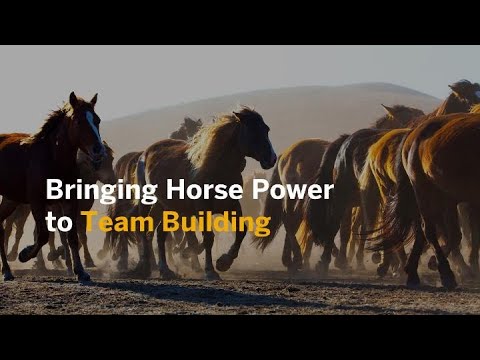Have you ever had a great idea when you were on vacation, jogging, or out for a walk? Often, when we break out of our routines, we start getting creative. This is the principle that SAP employees Nicole Machmeier and Sandra Thiel apply to their horse-assisted coaching program.
As soon as participants arrive at the stables, they’re exposed to new impressions: grassy meadows, the scent of hay and stables, the sound of horses neighing. The place seems a thousand miles away from a work desk. The horses draw mixed responses initially; some participants are wary around them, while others approach them with confidence. But all are curious about the four-legged co-trainers.
Inhibitions fade fast. “Just being around horses, stroking or feeding them, triggers positive emotions among the participants,” explains Machmeier. That’s due partly to oxytocin, one of the happy hormones, which floods our bodies when we interact with horses or pets.

Video by John Hunt and Nina Kippenhan.
“Working with horses for thousands of years has given us a special affinity with them,” explains Anabel Schroeder, founder of horsesense, which offers horse-assisted training and coaching. “People open up when they are around horses. Horses have a different brain wave pattern to humans and exhibit a Zen-like calm that humans can only reach through meditation. They also have a lower heart rate — just standing next to a horse and touching it makes you feel more relaxed.”
Global Coaching Program at SAP
Nicole Machmeier and Sandra Thiel are both certified horse-assisted coaches. While they offer this type of coaching on their own initiative, they also work for the Global Coaching Program at SAP. SAP is keen to nurture a coaching mindset among employees by creating an environment designed to help develop one’s full potential while enabling growth and a more engaged organization. Coaching is about fostering self-reflection. A coach helps through guidance in finding one’s own answers and unlocking hidden potential by asking thought-provoking questions.
Experts in Human Body Language
At first, the coaching exercises don’t sound that difficult. Participants are asked to guide their horse around a short obstacle course or lead it from point A to B without using their hands. But there’s a catch: Horses don’t always behave how we’d like them to.
These exercises are very insightful for the coaches because, as Machmeier explains, “participants always act exactly as they would in everyday life.” Some quickly feel the pressure, become impatient, or pull on the lead rope. Others are timid and try to coax the horse around the course using friendly encouragement. “In stressful situations, we cannot pretend and always revert to our familiar patterns of thinking, feeling, and behaving,” Schroeder shares.
According to Machmeier, “Horse-assisted coaching is a really effective way to mirror such behaviors.” With the exercises and joint reflection sessions, they help participants recognize what lies behind their outward reactions. “It’s all about understanding why something triggers you or stresses you out,” she says. The coaches often go through various exercises before they reach this point, and always following a four-step cycle: mirror behavior, encourage reflection, challenge, support.
Feedback from Horses Doesn’t Hurt
“Horses are sensitive creatures and have learned to read people; it’s their survival mechanism,” explains Schroeder. With keen senses, they react to people’s body language and pick up even the smallest emotional cue. “They gently mirror us without judging, and that doesn’t hurt as much as the feedback from our colleagues or managers. At the same time, people don’t resent the horse’s feedback, and that allows them to appreciate and accept it.”
Interacting with the horses can be an emotional learning experience. How does it feel when you complete your task perfectly, when the horse refuses to follow you, or when you fail to set boundaries? “These things don’t just happen in your head, you feel them, and you anchor those feelings in a completely different way,” Thiel explains.
“You’re more likely to remember what you learn through emotions than what you’re taught in a classroom,” Schroeder says. The two SAP coaches confirm that participants often still recall their experiences months or even years later.
“What’s really great is that when someone experiences an insight, wants to change a behavior, and we repeat the exercise, the horse immediately reacts differently,” reports Thiel. “Horses are always in the here-and-now and mirror the smallest change in behavior. That makes it very tangible for the participant.”
SAP employee Harald Monihart took part in horse-assisted coaching program while working for his previous employer: “Looking back, horse-assisted coaching was by far the best training I attended at the beginning of my leadership career. The process of self-reflection that you experience when you attempt to communicate with a horse is a truly unique experience. Almost six years later, I still remember the positive effects.”
“Leading Blind”
Machmeier and Thiel offer coaching sessions for teams, managers, and individual employees, including colleagues who return to work after burnout. Individual coaching sessions often focus on dealing with stress, setting boundaries, defining priorities, or learning to say “no,” while typical leadership topics include managing diverse or remote groups.
Teams that attend coaching are often looking to improve collaboration, mutual appreciation, and communication, to get to know each other’s strengths, and to address areas of conflict. Another focus is psychological safety. A study commissioned by Google found that highly effective, high-performing teams have one thing in common — they nurture a culture of trust in which employees feel it is safe to make and admit to mistakes.
“One of the ways we help teams build trust is with the ‘Leading Blind’ exercise,” Thiel shares. Here, one participant leads both a horse and a blindfolded colleague. Navigating the obstacle course while leading the horse and the colleague is a complex task that doesn’t always go smoothly. It’s important to communicate well and look out for each other. This provides plenty of scope for joint discussion and reflection afterwards.
“Teams operate on a functional level and a relationship level,” explains Machmeier. “For a team to be truly effective, you need both levels to be strong.”
In coaching, it is generally believed that those being coached are responsible for their own growth, and horse-assisted coaching is no different. The participant is the expert, and he or she decides what topics they want to address or which insights they derive from the program. “We can only provide the framework and give guidance,” Machmeier says. “Those being coached own the process.”
To round off the coaching session, participants are invited to reflect on what they’ve learned, how they plan to adopt the desired behaviors, and what the next steps are.
“You can really hear the mental cogs turning, it’s the beginning of a process,” says Thiel. And when the participants go home? “Everyone leaves with a huge smile on their face,” Machmeier confirms.
Is one day of coaching enough? “It’s certainly enough to provide an impulse,” says Schroeder. “People go home feeling deeply touched. Ideally, they will continue their coaching journey, but this doesn’t have to involve horses. This type of coaching is so powerful that even one day will set a lot of things in motion.”



